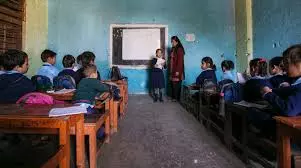John J. Kennedy | Rebuilding Trust In Public Education: How To Stop Drift To Private Schools
Teacher availability and quality also play a critical role. Government schools face issues like teacher absenteeism, insufficient training, and many single-teacher schools (23% in Telangana in 2023-24)

The steady decline in student enrolment in government schools across India signals a growing crisis in public education. The ministry of education has cautioned all the states, urging them to take remedial measures. Rightly so. Because, despite significant investments under Centrally-sponsored schemes like Samagra Shiksha and initiatives like PM-POSHAN, many parents are increasingly choosing private schools. This trend persists even in states with extensive public school networks. Understanding why many parents are moving away from government schools requires examining academic experiences, infrastructure, teacher quality, and broader social perceptions.
Parents largely perceive private schools as offering superior academic outcomes. Reports from the Annual Status of Education Report (ASER) and UDISE+ repeatedly reveal that government schools lag in basic literacy and numeracy, especially in rural areas. Private schools, by contrast, are seen as providing more structured environments with regular homework, tests, and a curriculum geared toward board exam success, appealing to aspirational families. Infrastructure deficiencies in government schools further discourage enrolment; many lack clean toilets, drinking water, adequate classrooms, and digital facilities. Chronic shortages of these essentials push parents toward private options that promise better physical resources, even if the quality varies.
Teacher availability and quality also play a critical role. Government schools face issues like teacher absenteeism, insufficient training, and many single-teacher schools (23% in Telangana in 2023-24). Private schools often have better teacher-student ratios and stricter accountability, though not all teachers are formally trained. The strongest pull factor is English-medium instruction. The private schools’ emphasis on English is viewed as crucial for social mobility and better job prospects, while government schools primarily use regional languages. Despite research supporting early learning in the mother tongue to improve comprehension, parental preference for English education remains dominant.
Branding and marketing further enhance private schools’ appeal. They promote themselves as “world-class” education providers, offering extra-curricular activities like robotics, arts, and sports.
Although government schools have produced notable scientists, social scientists, and technocrats, they rarely highlight these achievements, weakening their public image. The Covid-19 pandemic briefly increased government school enrolment as economic pressures mounted, but many parents reverted to private schools afterwards, citing better online learning and perceived stability.
When comparing academic experiences, private schools offer more disciplined and outcome-focused environments. ASER 2018 showed that only half of Class 5 government school students could read a Class 2 level text, while private school students generally fared better. This gap is influenced by school quality and socio-economic factors like parental education and home support. Private schools typically provide more extra-curricular opportunities and skills training, such as communication and critical thinking, which government schools struggle to implement consistently despite programmes like Samagra Shiksha. The government schools’ potential is undermined by inconsistent execution of policies and resource limitations.
A state-wise analysis reveals nuanced patterns. Andhra Pradesh has 73 per cent government schools but only 46 per cent enrolment, reflecting poor infrastructure and perceived academic weaknesses.
Telangana’s 70 per cent government schools’ share sees only 38.11 per cent enrolment, with private schools preferred, especially after the Covid-19 pandemic, for their English-medium instruction and stability. Uttarakhand’s enrolment in government schools is just 36.68 per cent, affected by rural access issues and teacher shortages. Tamil Nadu, with a strong educational legacy, has only 37 per cent of students in government schools, overshadowed by private schools’ English focus and branding. Kerala and Maharashtra report enrolment dips and confirm urban demand for private education. The northeastern states face similar declines in public school attendance due to poor access and understaffing.
However, the notion that private schools have a superior standard is partly a myth. In fact, quality varies widely among private institutions; some are excellent, while others suffer from unregulated profit motives and untrained teachers. Government schools, particularly in the southern states, have produced distinguished alumni, showing that excellence is possible. The issue lies in visibility, accountability, and responsiveness to parental expectations. Here, the private schools currently hold an edge.
Reversing the decline in government school enrolment requires concerted action. Upgrading infrastructure to provide safe classrooms, functional toilets, clean drinking water and digital resources is absolutely essential. Improving teacher quality through regular training, better remuneration and accountability can boost morale and effectiveness. Reducing single-teacher schools is critical. Additionally, governments must rebuild the public school brand by highlighting alumni
successes and running campaigns to restore community trust. Introducing optional English-medium sections without compromising mother-tongue instruction, a multilingual approach as exemplified by some states, can help address parental concerns. Expanding extracurricular and co-curricular programmes to develop soft skills and career counselling will make public schools more competitive with private alternatives. Real-time data monitoring, such as UDISE+, can help identify weak spots and tailor interventions effectively.
While the government’s stated commitment to public education is clear through schemes like Samagra Shiksha and PM-POSHAN, the unchecked proliferation of private schools raises questions about political and economic interests. School closures and mergers in government systems disproportionately affect marginalised communities, while private schools continue to expand. If equity is the goal, stricter regulation of private school growth and reinvestment in public schools must be priorities.
Ultimately, the shift away from government schools is not solely about objective quality but about perception, aspiration, and systemic shortcomings. Parents seek better facilities, qualified and trained teachers, more opportunities, and especially English-medium education.
Governments must invest, innovate, and communicate more effectively to restore faith in government schools. Private schools’ rise is not inherently negative but must be managed to prevent widening social inequities. The onus is now on the various governments to respond decisively and ensure that quality education remains accessible to all, fulfilling India’s constitutional promise of equitable learning opportunities.
The writer is retired professor and former dean of the School of Arts and Humanities at Christ University in Bengaluru
